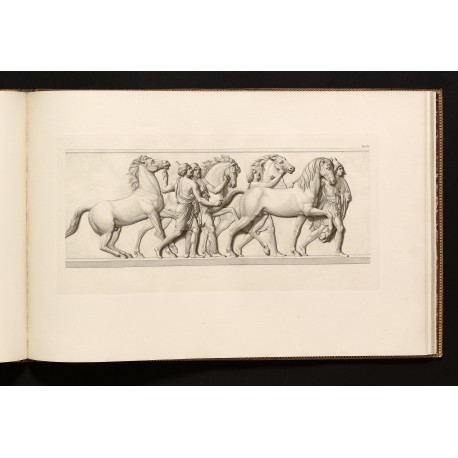Alexanders des Grossen Einzug in Babylon. Marmorfries im Königlich Dänischen Schlosse Christiansburg von Bertel Thorwaldsen. Nach Zeichnungen von Fr. Overbeck und Andern gestochen von Samuel Amsler. Mit Erläuterungen von Ludwig Schorn
- Subjects
- Book illustration - Artists, German - Amsler (Samuel), 1791-1849
- Book illustration - Artists, German - Overbeck (Johann-Friedrich), 1789-1869
- Sculpture - Artists, Danish - Thorvaldsen (Bertel), c. 1770-1844
- Authors/Creators
- Thorvaldsen, Bertel, c. 1770-1844
- Artists/Illustrators
- Amsler, Samuel, 1791-1849
- Overbeck, Johann-Friedrich, 1789-1869
- Thorvaldsen, Bertel, c. 1770-1844
- Printers/Publishers
- Cotta von Cottendorf, Johann Georg, active 1832-1855
- Felsing, [Johann Heinrich?], active 1823?-1831?
- Verlag der Literarisch-Artistischen Anstalt (Munich), 1835
- Other names
- Schorn, Johann Karl Ludwig von, 1793-1842
Thorvaldsen, Bertel
Copenhagen 1770 – 1844 Copenhagen
Alexanders des Grossen Einzug in Babylon. Marmorfries im Königlich Dänischen Schlosse Christiansburg von Bertel Thorwaldsen. Nach Zeichnungen von Fr. Overbeck und Andern gestochen von Samuel Amsler. Mit Erläuterungen von Ludwig Schorn.
Munich, Verlag der literarisch-artistischen Anstalt [letterpress printed at Stuttgart, by J.G. Cotta; engravings printed at Darmstadt, by J.H. Felsing], 1835
oblong folio (375 × 580 mm), (4) ff. letterpress, unsigned (title, transcribed above; dedication to Ludwig i of Bavaria, subscribed by J.G. Cotta; descriptions of the plates in double columns numbered 1–8); plus twenty-two plates (i–xxi showing segments, and last unnumbered plate showing the relief as a whole), of which plates xiii, xx are signed with Amsler’s monogram, and last, unnumbered plate signed Wilhelm Müller sculp Weimar (credit line on plate xiv: H. Felsing impr. Darmstadt).
Letterpress and several plates thoroughly foxed, occasional spotting elsewhere; light abrasions to the binding, headcap torn.
bound in russia leather, decorated in gilt and blind, marbled endpapers, sprinkled page edges; probably by Philipp Selenka of Wiesbaden (see below).
A suite of prints reproducing Thorvaldsen’s monumental frieze of the ‘Entrance of Alexander the Great into Babylon’, engraved by Samuel Amsler (1791–1848) after drawings by Johann Friedrich Overbeck (1789–1869) and anonymous draughtsmen. The accompanying text was supplied by (Johann Karl) Ludwig Schorn (1793–1842), editor of the ‘Kunst-Blatt’ and professor at the Ludwig-Maximilians-Universität in Munich.
Born in the village of Schinznach, near Wildegg, Canton Aargau, Amsler was successively apprenticed to the engravers Johann Heinrich Lips, in Zurich, and to Carl Hess, in Munich. In 1816 he travelled to Rome, associating there with artists of the Nazarene movement such as Koch, Cornelius, and Overbeck, though he never became a Nazarene himself. In 1817 Amsler drew and later engraved two of Thorvaldsen’s recent sculptures, the life-sized ‘Goddess of Hope’ and the ‘Shepherd Boy’.1 Thorvaldsen was so impressed by these prints that he commissioned from Amsler a new series of engravings of his Alexander frieze, even though it already had been engraved by Pietro Bettelini (1763–1829) and Domenico Marchetti (1780–1844).2
Unlike Bettelini and Marchetti, Amsler based his engravings not on Thorvaldsen’s original frieze in the Palazzo Quirinale (1812), but on the third and largest version made for Christiansborg Palace in Copenhagen (1818–1827), where the dimensions of the room had required Thorvaldsen to lengthen the frieze by introducing additional single figures. Amsler worked from the same drawings by Overbeck used by the Italian engravers and from supplementary drawings made by other artists especially for the purpose.3 Amsler is documented in Wildegg in 1825 and 1827–1829 working on the engravings, and in Munich in 1829 he put the final touches to the last five matrices. Publication was delayed until 1835. The printer is identified at the foot of one of the pages of text: ‘Druck der Offizin der J.G. Cotta’schen Buchhandlung in Stuttgart’; one of the plates is signed: ‘H. Felsing impr. Darmstadt’.
Plates i–xxi are uncaptioned; however Schorn’s explanatory text presents them in four groups: i–vi showing the Euphrates and city walls; vii–xii, tributes of homage; xiii–xvi, Alexander, deities and followers; xvii–xxi, the train of the Macedonian army. The last, unnumbered plate provides an overview of the frieze. In some copies, Schorn’s German text is replaced (or supplemented) by French (‘Entrée d’Alexandre le Grand à Babylone’) or English (‘The Entrance of Alexander the Great into Babylon’) translation.
New editions (edited by Hermann Luecke) were published at Leipzig 1870–1882.4
Contemporary South German binding
Our binding is decorated by a set of tools associated with Philipp Selenka (1803–1850) of Wiesbaden, brother of Johann Jacob Selenka (1801–1871), Hofbuchbinder in Braunschweig.5
reference Charles Le Blanc, Manuel de l’amateur d’estampes (Paris 1854), i, p.9 nos. 13–33
1. Amsler’s pencil drawings for these engravings are in Copenhagen, Thorvaldsen Museum, ‘Drawings by other artists’, Inv. D1–D2. The prints are praised by Ludwig Shorn, ‘Kupferstiche und Zeichnung von Samuel Amsler aus Schinznach’, in Morgenblatt für gebildete Leser: Kunst-Blatt, no. 80, 5 October 1820, pp.317–319 (‘Zwey noch nicht in den Kunsthandel gekommene Blätter’).
2. The Frankfurt publisher and art dealer Johann Friedrich Wenner, who was in Rome from July 1814 to March 1815, commissioned the prints from Bettelini and Marchetti. The set of eighteen plates was completed in 1815–1816, and first circulated in 1818; see Heidelberger Jahrbücher der Literatur 11 (1818), ‘Allgemeiner Bericht von neuen Büchern, Landkarten, Musikalien und andern Kunstartikeln. Juli, August und September 1818’, p.177. In 1838, Wenner and the Frankfurt editor Carl Jügel invited subscriptions for new editions (in German and French).
3. Overbeck’s drawings are in Copenhagen, Thorvaldsen Museum, ‘Drawings by other artists’, Inv. D19–D33; the anonymous drawings are D42–D48.
4. Unter Glas und Rahmen: Druckgraphik der Romantik aus den Beständen des Landesmuseums Mainz und aus Privatbesitz, catalogue of an exhibition held at Landesmuseum Mainz, 9 May–20 June 1993, edited by Stephan Seeliger and Norbert Suhr (Mainz 1993), p.148.
5. Two bindings by Philipp Selenka in the Fürstlich Waldecksche Hofbibliothek, Arolsen, are described by Rudolf-Alexander Schütte and Konrad Wiedemann, Einbandkunst vom frühmittelalter bis Jugendstil aus den Bibliotheken in Kassel und Arolsen, Universitätsbibliothek Kassel (Kassel 2002), p.54 no. 68 and Abb. 51. He was a specialist ‘Portefeuillearbeiter’; see Hektor Rössler, Ausführlicher Bericht über die von dem Gewerbverein für das Großherzogthum Hessen im Jahre 1842 veranstaltete Allgemeine deutsche Industrie-Ausstellung zu Mainz (Darmstadt 1843), p.240.






